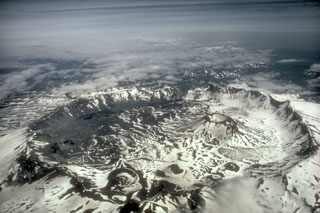Report on Aniakchak (United States) — 22 February-28 February 2023
Smithsonian Institution / US Geological Survey
Weekly Volcanic Activity Report, 22 February-28 February 2023
Managing Editor: Sally Sennert.
Please cite this report as:
Global Volcanism Program, 2023. Report on Aniakchak (United States) (Sennert, S, ed.). Weekly Volcanic Activity Report, 22 February-28 February 2023. Smithsonian Institution and US Geological Survey.
Aniakchak
United States
56.88°N, 158.17°W; summit elev. 1341 m
All times are local (unless otherwise noted)
On 22 February AVO raised the Aviation Color Code for Aniakchak to Yellow (the second lowest level on a four-color scale) and the Volcano Alert Level to Advisory (the second lowest level on a four-level scale) due to a recent increase in the number of earthquakes and a shallowing of those events. Background seismicity was generally characterized as deep (more than 15 km below sea level) long-period events occurring at a rate of about four events per month. Beginning in October 2022 the rate increased, and the earthquakes were located at depths less than 9 km below sea level. The earthquake rate further increased on 31 January and was sustained with dozens of earthquakes detected per day, including a M 3.7 earthquake recorded on 17 February.
Elevated seismicity continued during 23-27 February at a variable rate. Dozens of earthquakes were recorded daily during 22-26 February, though more than one hundred small earthquakes (not all locatable) were detected during 24-25 February. Small earthquakes occurred at the rate of about 10 per hour during 26-28 February. AVO noted that there was no indication that an eruption of Aniakchak was imminent, or that one will occur. Increases in seismic activity have been detected previously at other similar volcanoes, with no subsequent eruptions.
Geological Summary. One of the most dramatic calderas of the Aleutian arc, the 10-km-wide Aniakchak caldera formed around 3,400 years ago during a voluminous eruption in which pyroclastic flows traveled more than 50 km N to the Bering Sea and also reached the Pacific Ocean to the south. At least 40 explosive eruptions have been documented during the past 10,000 years, making it the most active volcano of the eastern Aleutian arc. A dominantly andesitic pre-caldera volcano was constructed above basement Mesozoic and Tertiary sedimentary rocks that are exposed in the caldera walls to elevations of about 610 m. The ice-free caldera floor contains many pyroclastic cones, tuff cones, maars, and lava domes. Surprise Lake on the NE side drains through The Gates, a steep-walled breach on the east side of the 1-km-high caldera rim that was the site of catastrophic draining of a once larger lake about 1850 years BP. Vent Mountain and Half Cone are two long-lived vents on the south-central and NW caldera floor, respectively. The first and only confirmed historical eruption took place in 1931 from vents on the west and SW caldera floor.
Source: US Geological Survey Alaska Volcano Observatory (AVO)

